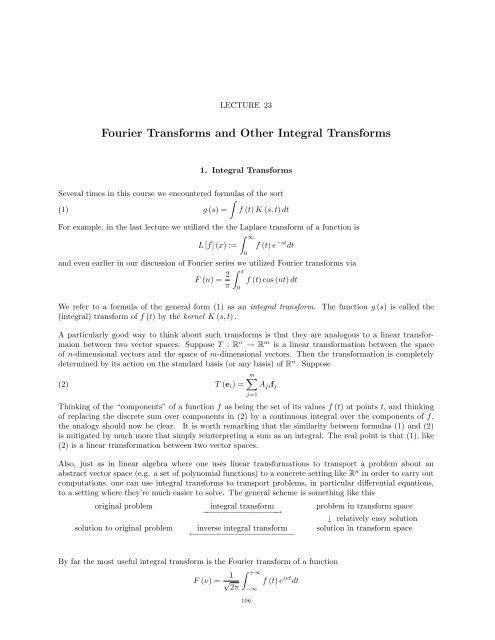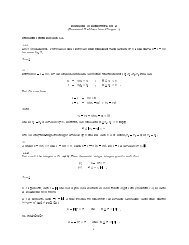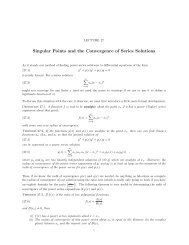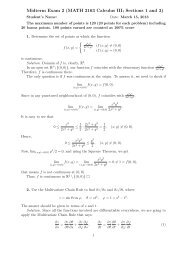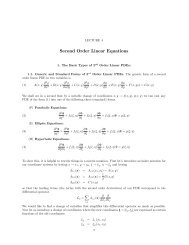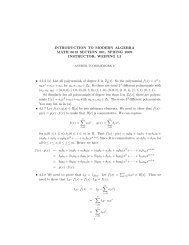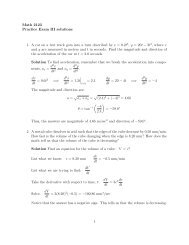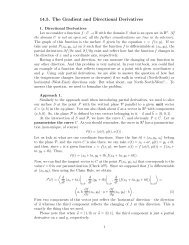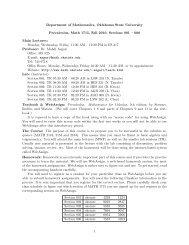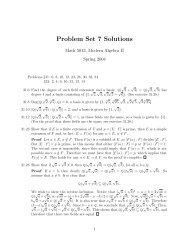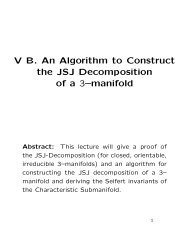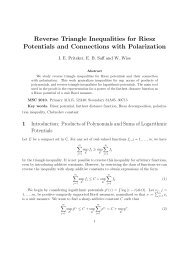Lecture 23: Fourier Transforms and Other Integral Transforms
Lecture 23: Fourier Transforms and Other Integral Transforms
Lecture 23: Fourier Transforms and Other Integral Transforms
Create successful ePaper yourself
Turn your PDF publications into a flip-book with our unique Google optimized e-Paper software.
LECTURE <strong>23</strong><strong>Fourier</strong> <strong>Transforms</strong> <strong>and</strong> <strong>Other</strong> <strong>Integral</strong> <strong>Transforms</strong>1. <strong>Integral</strong> <strong>Transforms</strong>Several times in this course we encountered formulas of the sort∫(1) g (s) = f (t) K (s, t) dtFor example, in the last lecture we utilized the the Laplace transform of a function isL [f] (x) :=∫ ∞0f (t) e −st dt<strong>and</strong> even earlier in our discussion of <strong>Fourier</strong> series we utilized <strong>Fourier</strong> transforms viaF (n) = 2 π∫ π0f (t) cos (nt) dtWe refer to a formula of the general form (1) as an integral transform. The function g (s) is called the(integral) transform of f (t) by the kernel K (s, t) .A particularly good way to think about such transforms is that they are analogous to a linear transformaionbetween two vector spaces: Suppose T : R n → R m is a linear transformation between the spaceof n-dimensional vectors <strong>and</strong> the space of m-dimensional vectors. Then the transformation is completelydetermined by its action on the st<strong>and</strong>ard basis (or any basis) of R n . Supposem∑(2) T (e i ) = A ji f jThinking of the “components” of a function f as being the set of its values f (t) at points t, <strong>and</strong> thinkingof replacing the discrete sum over components in (2) by a continuous integral over the components of f,the analogy should now be clear. It is worth remarking that the similarity between formulas (1) <strong>and</strong> (2)is mitigated by much more that simply reinterpreting a sum as an integral. The real point is that (1), like(2) is a linear transformation between two vector spaces.Also, just as in linear algebra where one uses linear transformations to transport a problem about anabstract vector space (e.g. a set of polynomial functions) to a concrete setting like R n in order to carry outcomputations, one can use integral transforms to transport problems, in particular differential equations,to a setting where they’re much easier to solve. The general scheme is something like thisoriginal problemsolution to original problemj=1integral transform−−−−−−−−−−−−−−−−→inverse integral transform←−−−−−−−−−−−−−−−−−−−−−−problem in transform space↓ relatively easy solutionsolution in transform spaceBy far the most useful integral transform is the <strong>Fourier</strong> transform of a functionF (ν) = √ 1 ∫ +∞f (t) e iνt dt2π−∞106
2. THE FOURIER TRANSFORM 107In many applications this is generally thought of as a way of identifying the frequency components of atime-varying function; but the utility of this transform really extends far beyond such applications. Twoother common integral transforms are(<strong>Fourier</strong>-Bessel) g (α) =(Mellin transform) g (α) =∫ ∞0∫ ∞0f (t) J n (αt) dtf (t) t α−1 dt2. The <strong>Fourier</strong> TransformThe big advantage of the Laplace transform is that it can be used to reduce a differential equation to analgebraic equation. However, in practice the Laplace transform also comes with a disadvantage, the inverseLaplace transform taking the solution in the transform space back to the original space is often difficult tocompute.Recall that when we were utilizing <strong>Fourier</strong> series, we were using formulasf (x) = a ∞ 02 + ∑ ( nπx) ∞∑ ( nπxa n cos + b n sinLLn=1n=1a n = 1 ∫ L( ) nπtf (t) cos dtL −LLb n = 1 ∫ L( ) nπtf (t) sin dtLL−Lto exp<strong>and</strong> functions on the integral [−L, L] in terms of functions. Let’s consider what happens with theseformulas as L → ∞. We havef (x) = 1 ∫ Lf (t) dt + 1 ∞∑∫ L( ) nπt( nπx)f (t) cos cos dt2L −L Ln=1 −LL L+ 1 ∞∑∫ L( ) nπt( nπx)f (t) sin sin dtLn=1 −LL L= 1 ∫ L∞∑∫1 L ( nπ)f (t) dt +f (t) cos2L −LL −L L (t − x) dtn=1Now if f (t) is an integrable function on the real line; i.e.,∫ Lf (t) dt∣ ∣ < ∞ThenOn the other h<strong>and</strong>, if we setlimL→∞−L∫1 Lf (t) dt = 02L −Lω = nπ L)then∆w = π L∞∑n=1∫1 L ( nπ)f (t) cosL −L L (t − x) dt =∞∑n=1∆wπ∫ L−Lf (t) cos (w (t − x)) dt
2. THE FOURIER TRANSFORM 108<strong>and</strong> so when we let L → ∞, ∆w → 0 <strong>and</strong> the expression on the right, interpreted as a Riemann sum over∆w, becomes∫1 ∞ ∫ ∞dω f (t) cos (ω (t − x)) dxπ 0 −∞We can thus infer that, in the limit L → ∞, the <strong>Fourier</strong> expansion formula (1) becmesf (x) = 1 π∫ ∞0dω∫ ∞−∞f (t) cos (ω (t − x)) dxNow since f (t) cos (ω (t − x)) is a even function of ω we can rewrite (2) asf (x) = 12π∫ ∞−∞dω∫ ∞−∞f (t) cos (ω (t − x)) dx<strong>and</strong> because f (t) sin (ω (t − x)) is an odd function of ω, we also haveIf we now usewe can write0 = 12π∫ ∞−∞dω∫ ∞−∞f (t) sin (ω (t − x)) dxe iy = cos (y) + i sin (y)f (x) = 1 ∫ ∞ ∫ ∞dω f (t) e i(t−x)ω dx2π −∞ −∞because the integral over the odd part of e i(t−x)ω will not contribute to the total integral.Reversing the order of integration we obtain the formulaf (x) = 1 ∫ ∞(∫ ∞)f (t) e i(t−x)ω dω dt2π −∞−∞which suggests that12π∫ +∞−∞e i(t−x)ω dω = δ (t − x)On the other h<strong>and</strong>, suppose we define the <strong>Fourier</strong> Transform of f to beF [f] (ω) = √ 1 ∫ +∞f (x) e −ixω dx2π−∞<strong>and</strong> the Inverse <strong>Fourier</strong> Transform of a function g (ω) to beThenForF −1 [F [f]] (x) =F −1 [g] (x) = 1 √2π∫ ∞−∞F −1 [F [f]] (x) = f (x)= 12π=∫1 ∞√2π−∞∫ ∞−∞∫ ∞−∞= f (x)<strong>and</strong> so F <strong>and</strong> F −1 are truly inverses of each other.[∫ ∞f (t)g (w) e iωt dω]f (t) e −iωt dt e iωx dω−∞[∫ ∞]e iω(x−t) dω dt−∞f (t) δ (x − t) dt
3. THE WAVE AND EQUATION AND FOURIER TRANSFORMS 1093. The Wave <strong>and</strong> Equation <strong>and</strong> <strong>Fourier</strong> <strong>Transforms</strong>Considerφ tt − c 2 φ xx = 0φ (x, 0) = f (x)φ t (x, 0) = 0Suppose we take the <strong>Fourier</strong> transforms of this PDE with respect to x :ThenΦ (ω, t) := F x [φ] =∫ +∞−∞φ (x, t) e −iωx dx[ ] ∫ ∂φ ∞∂ 2 φF x∂x 2 =−∞ ∂x 2 e−iωx dxIntegrating by parts twice <strong>and</strong> assuming lim x→±∞ φ (x, 0) = 0 (which is reasonable for any finite energysolution) so that the contributions from the boundaries vanish, we have[ ] ∫ ∂φ ∞∂ 2 ( )φ ∂2∫ ∞F x∂x 2 =−∞ ∂x 2 ∂x 2 e−iωx dx = −ω 2 φ (x, t) e −iωx dx = −ω 2 F x [φ]−∞<strong>and</strong> so the <strong>Fourier</strong> transforms of the differential equation <strong>and</strong> initial condiations are∂ 2∂t 2 Φ (ω, t) + c2 ω 2 Φ (ω, t) = 0The differential equation for Φ (ω, t) is easily solvedImposing the boundary conditions on Φ (ω, t) yieldsAnd soWe thus haveΦ (ω, 0) = F (ω) := F x [f] (ω)Φ t (ω, 0) = 0Φ (ω, t) = A (ω) e icωt + B (ω) e −icωtA (ω) + B (ω) = F (ω)icωA (ω) − icωB (ω) = 0A (ω) = B (ω) = 1 2 F (ω)Φ (ω, t) = 1 2 F (ω) eicωt + 1 F (ω) e−icωt2as the <strong>Fourier</strong> transform of the solution φ (x, t) of the original PDE/BVP. To recover φ (x, t) all we need tois apply the inverse <strong>Fourier</strong> transform∫1 ∞( 1φ (x, t) = √2π 2 F (ω) eicωt + 1 )2 F (ω) e−icωt e iωx dω=12 √ 2π−∞∫ ∞−∞= 1 2 f (x + ct) + 1 f (x − ct)2F (ω) e iω(x+ct) dω + 1 ∫ ∞2 √ F (ω) e iω(x−ct) dω2π −∞
4. DIFFUSION EQUATION WITH A INSTANTANEOUS SOURCE 1104. Diffusion Equation with a Instantaneous SourceConsider the PDE/BDEφ t − a 2 φ xx = 0φ (x, 0) = Sδ (x)which would govern the diffusion of S particles released at a point x = 0 at time t = 0 in a 1-dimensionalmedium. Taking the <strong>Fourier</strong> transform with respect to x of both the PDE <strong>and</strong> the initial condition yields∂∂t Φ (ω, t) + a2 ω 2 Φ = 0Φ (ω, 0) =∫1 ∞√2π−∞The differential equation for Φ (ω, t) has as its general solutionΦ (ω, t) = A (ω) e −a2 ω 2 tSe −iωx dx =To obtain the coefficient A (ω), we just apply the <strong>Fourier</strong> transform of the boundar condition. This gives usΦ (ω, t) =S √2πe −a2 ω 2 tS √2πNow it turms out thatF −1 ( e pω2) = 1 √ 2pe − x24p(This one can look up in a Table of <strong>Fourier</strong> <strong>Transforms</strong>). Finally, we recover the solution to the originalproblem by applying the inverse Laplace transform. We thus arrive atS 1φ (x, t) = √ √2π 2a2 t exp ( −x 2 /4a 2 t )=S√4πa2 t e−x2 /(4a 2 t)


